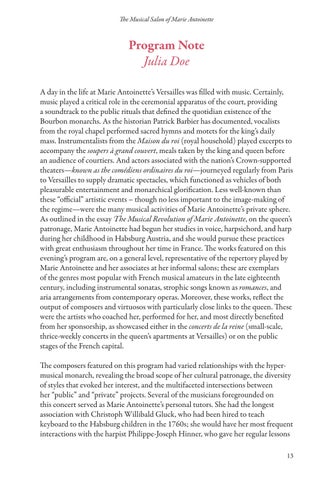The Musical Salon of Marie Antoinette
Program Note Julia Doe A day in the life at Marie Antoinette’s Versailles was filled with music. Certainly, music played a critical role in the ceremonial apparatus of the court, providing a soundtrack to the public rituals that defined the quotidian existence of the Bourbon monarchs. As the historian Patrick Barbier has documented, vocalists from the royal chapel performed sacred hymns and motets for the king’s daily mass. Instrumentalists from the Maison du roi (royal household) played excerpts to accompany the soupers à grand couvert, meals taken by the king and queen before an audience of courtiers. And actors associated with the nation’s Crown-supported theaters—known as the comédiens ordinaires du roi—journeyed regularly from Paris to Versailles to supply dramatic spectacles, which functioned as vehicles of both pleasurable entertainment and monarchical glorification. Less well-known than these “official” artistic events – though no less important to the image-making of the regime—were the many musical activities of Marie Antoinette’s private sphere. As outlined in the essay The Musical Revolution of Marie Antoinette, on the queen’s patronage, Marie Antoinette had begun her studies in voice, harpsichord, and harp during her childhood in Habsburg Austria, and she would pursue these practices with great enthusiasm throughout her time in France. The works featured on this evening’s program are, on a general level, representative of the repertory played by Marie Antoinette and her associates at her informal salons; these are exemplars of the genres most popular with French musical amateurs in the late eighteenth century, including instrumental sonatas, strophic songs known as romances, and aria arrangements from contemporary operas. Moreover, these works, reflect the output of composers and virtuosos with particularly close links to the queen. These were the artists who coached her, performed for her, and most directly benefited from her sponsorship, as showcased either in the concerts de la reine (small-scale, thrice-weekly concerts in the queen’s apartments at Versailles) or on the public stages of the French capital. The composers featured on this program had varied relationships with the hypermusical monarch, revealing the broad scope of her cultural patronage, the diversity of styles that evoked her interest, and the multifaceted intersections between her “public” and “private” projects. Several of the musicians foregrounded on this concert served as Marie Antoinette’s personal tutors. She had the longest association with Christoph Willibald Gluck, who had been hired to teach keyboard to the Habsburg children in the 1760s; she would have her most frequent interactions with the harpist Philippe-Joseph Hinner, who gave her regular lessons 13





